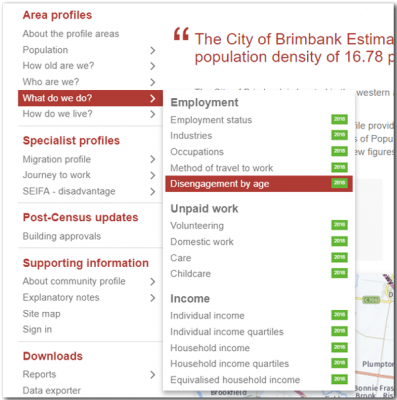In this blog, Glenn introduces our new Disengagement dataset, now available in all community profiles, to show which age-groups in your community are not currently ‘earning or learning’.
Disengagement from the labour force and education is an important concept in social planning, and understanding the needs of disadvantaged communities.
This is a new variable which was released from the 2016 Census, though it could be derived from earlier Census years, and we have long had “Disengaged youth” as a page on our social atlas maps. This is one of the most popular pages among our users.
To be “engaged”, a person is either employed full-time, studying full-time, or a combination of part-time work and study. Someone who is partially engaged is either employed part-time or studying part-time. Those who are “Disengaged” are neither in employment or education. This is considered a vulnerable group who may be indicative of the need for training programs and support to get into the workforce.
Of course this is highly dependent on age. Usually, the 15-24 year age group are the ones most closely looked at in this area. It’s generally considered that around that age, young people, if they are not employed, should be studying towards employment.
Older than that, there are potentially more reasons for disengagement. For example, parents staying home to have children, and, after the age of 65, most people are disengaged, simply by virtue of being retired. But this is an important population to look at as well, with substantial increases in people working past 65 showing in the last Census.
After consultations with our users, .id have expanded our coverage of the Disengagement topic to cover all age groups, and levels of engagement in employment and education. We are pleased to announce that this is now a new page available for all places that subscribe to our local community profiles, profile.id.
To view this data for your local area, open the community profile for your council or regional authority, and find ‘Disengagement by age’ alongside other employment topics under the ‘What do we do?’ menu.

How to analyse disengagement data
Disengagement from the labour force and education among the young tends to be higher in very low socio-economic areas where there is a greater level of welfare dependency, including social housing areas. It is also higher in areas which are very distant from education opportunities. In some rural areas, if young people don’t have a job, there is no opportunity for education unless they leave. So these areas may also have higher levels of disengagement.
Here are the results for the City of Brimbank, Victoria, and Northern Beaches, NSW.

Brimbank has a high level of disengagement in all age groups. In total, 10.3% of all youth are not engaged. It’s also higher in the older age groups. with the difference most marked among 55-64-year-olds, 40% of whom were not working or in education (early retired?). This is typical of areas with a lot of blue-collar jobs, which due to physical requirements may not enable workers to stay on as long in the labour force. Employers like the automotive industry have also been downsizing in recent years, causing older workers to lose their jobs.
Looking at a more disadvantaged suburb in Brimbank, like the suburb of Albion, shows a much higher rate of youth disengagement, but among older workers it’s similar to the LGA average.
This is more typical of the age profile of the area, with affordable rental housing stock, attracting younger adults.
On the other hand, an affluent area such as the Northern Beaches of Sydney shows a very low rate of disengagement, both among youth, with ready access to a major employment market and universities, and among older population.

In Northern Beaches, even at 65+, a large number of people are still working part-time, leading to the “Partial engagement” category. Overall, about 1 in 6 (17%) of those aged 65+ in Northern Beaches were still working or in education.
This illustrates the strong correlation the level of workforce and educational engagement has to socio-economic status. It feeds into the SEIFA indexes, and is another way for Local Government to look at the type of support services which may be needed in the community, as well as playing an advocacy role in the local area.
Disengagement by Age is now live on all profile.id sites. If you’re with a council or regional authority who doesn’t have a community profile, contact us here to learn more about accessing this resource in your area.



.jpg)







